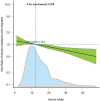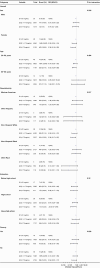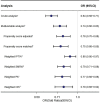Association between serum folate levels and migraine or severe headaches: A nationwide cross-sectional study
- PMID: 39533580
- PMCID: PMC11557034
- DOI: 10.1097/MD.0000000000040458
Association between serum folate levels and migraine or severe headaches: A nationwide cross-sectional study
Abstract
Migraine and severe headaches are common neurological disorders with significant societal impact. Previous research indicates a potential link between serum folate levels and migraine occurrence, yet there is a lack of sufficient relevant studies and more are required. This study aimed to determine the association between a severe headache or migraine and serum folate levels in large populations. Using data from the National Health and Nutrition Examination Survey, we conducted a cross-sectional study. Using multivariable logistic regression models, we investigated the association between serum folate and severe headache or migraine. In a subsequent subgroup analysis, several confounding factors were also explored to investigate the association between migraine and serum folate. A total of 13,351 individuals participated in the study, with 2742 reporting severe headache or migraine in the previous 3 months. Serum folate was negatively associated with severe headache or migraine (odds ratio [OR] = 0.5, 95% confidence interval [CI] = 0.28-0.89, P = .018). The stratified analysis revealed this association persisted among female (OR = 0.38, 95% CI = 0.18-0.82, P < .001), individuals aged 20 to 50 years (OR = 0.53, 95% CI = 0.28-0.99, P < .001), and non-Hispanic White participants (OR = 0.38, 95% CI = 0.17-0.87, P < .001). We found that greater levels of serum folate were significantly related to a decreased likelihood of migraine onset, especially among women, young and middle-aged populations, and non-Hispanic White participants. Further research is required to validate and expand upon our results.
Copyright © 2024 the Author(s). Published by Wolters Kluwer Health, Inc.
Conflict of interest statement
The authors have no funding and conflicts of interest to disclose.
Figures




References
-
- Lipton RB, Stewart WF, Diamond S, Diamond ML, Reed M. Prevalence and burden of migraine in the United States: data from the American Migraine Study II. Headache. 2001;41:646–57. - PubMed
-
- Gross EC, Lisicki M, Fischer D, Sándor PS, Schoenen J. The metabolic face of migraine—from pathophysiology to treatment. Nat Rev Neurol. 2019;15:627–43. - PubMed
Publication types
MeSH terms
Substances
LinkOut - more resources
Full Text Sources
Medical

